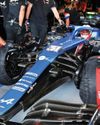
A Formula 1 car is an exceptionally harsh and ‘noisy’ place for a sensor, with many sources of vibration and electromagnetic interference (EMI) present, all of which have the potential to skew sensor readings and make life difficult for efficient performance.
EMI is the interference caused by one electrical or electronic device to another by the electromagnetic fields generated during its operation.
One of the biggest challenges faced in Formula 1 since introducing hybrid powertrains in 2014 has been protecting devices from the EMI produced by the high-voltage electrical circuits related to the energy recovery system (ERS) and, in particular, the motor-generator units (MGUs).
Even just packaging what is essentially very complex machinery that relies on sensitive measuring devices in such a way that they can survive under racing conditions has proven to be a major challenge for the engineers involved.
EMI is a particular issue in sensors with low output signals, such as strain gauges and thermocouples. Sensors such as pressure transducers can have an output voltage of 1-10V, whereas the output of strain gauges and thermocouples will only be a few milli- or microvolts.
In this case, a low signal-to-noise ratio can have a considerable impact on the recorded output of a sensor. This ratio is the level of a particular signal’s strength compared to the level of background noise.
For example, a sensor with a 5V output signal and a background level of signal noise of a few microvolts would have a very high signal-to-noise ratio. However, if the sensor output is in the millivolt range, the ratio is much lower, making it much harder to distinguish the signal from the noise.
Bu hikaye Racecar Engineering dergisinin July 2021 sayısından alınmıştır.
Start your 7-day Magzter GOLD free trial to access thousands of curated premium stories, and 8,500+ magazines and newspapers.
Already a subscriber ? Giriş Yap
Bu hikaye Racecar Engineering dergisinin July 2021 sayısından alınmıştır.
Start your 7-day Magzter GOLD free trial to access thousands of curated premium stories, and 8,500+ magazines and newspapers.
Already a subscriber? Giriş Yap
Talk the torque
More thoughts on in-wheel motors and their effects on twisting force
Rolling about
An explanation of the limitations of a previous load transfer article, bringing jacking forces into the mix
F1 breaks schedule records
The FIA has confirmed no fewer than 23 races on the 2022 Formula 1 World Championship schedule, the highest number of grands prix ever to be held in a single season, and that has led to criticism from some teams that will be on the road for eight months.

Under pressure
Toyota may have finished first and second at Le Mans this year, but the effort required to overcome a fuel delivery problem and finish with both cars was Herculean
Physics at work
Dutch company, Intrax, offers Racecar Engineering an insight into the technologies it employs to optimise its suspension products
Williams' 2030 ambition
Williams Racing has committed to becoming climate positive by 2030 as part of an all-new sustainability strategy.
Diff'rent strokes
Racecar looks at the different types of mechanical differential, their benefits and limitations
Das Boot
A curious Twitter exchange fired up a unique, hydrogen-powered, cross-country project that will contest the Baja 1000 in November 2022

Air born
Every racecar engineer's dream is a blank sheet of paper design. When Hoonigan and Subaru approached Vermont Sportscars about building the next generation of Gymkhana racer, that's just what the company was given

Remote control
Called variously ‘virtual garages’, ‘mission control’ or ‘race support rooms’ is the future of race engineering sitting in the warm back at HQ?